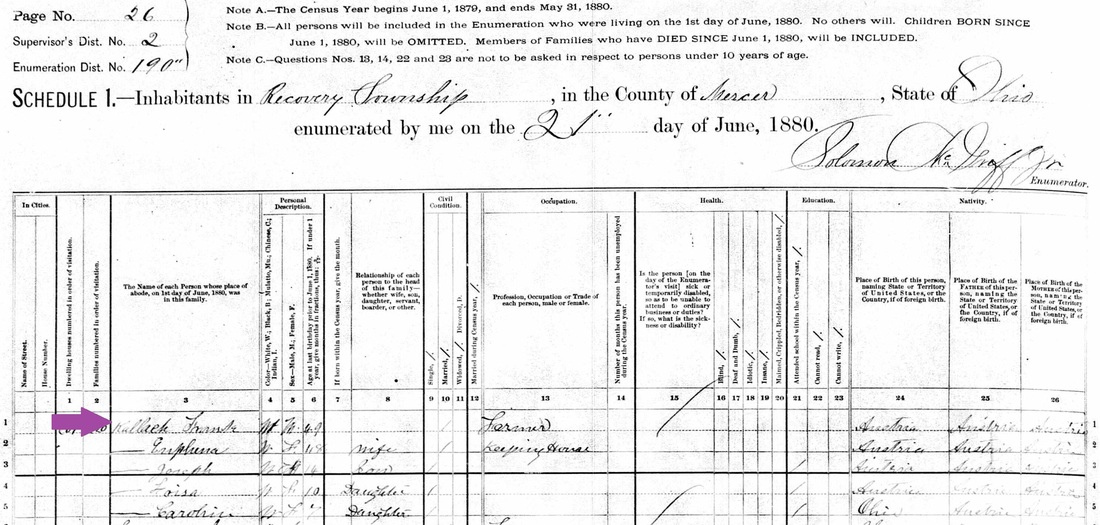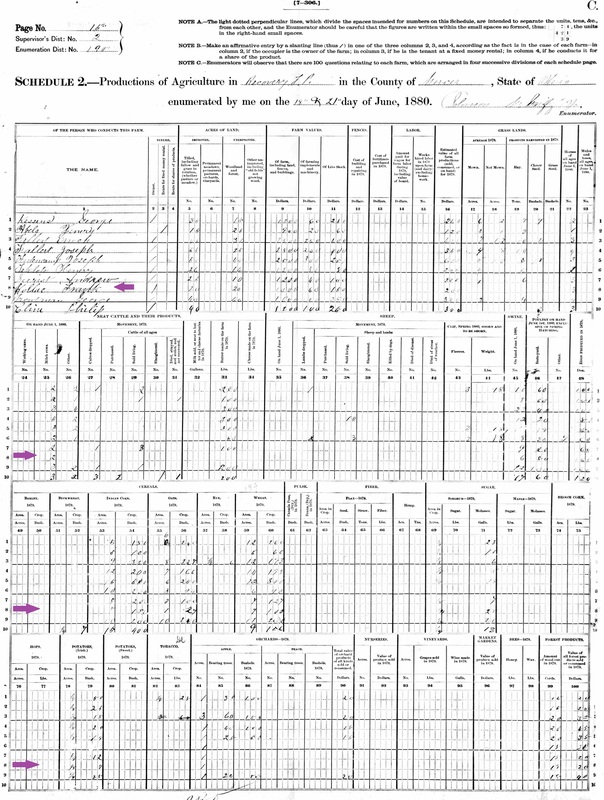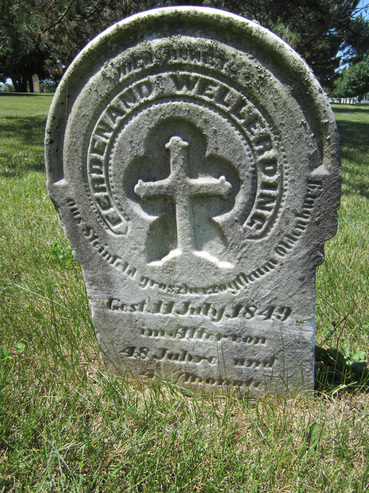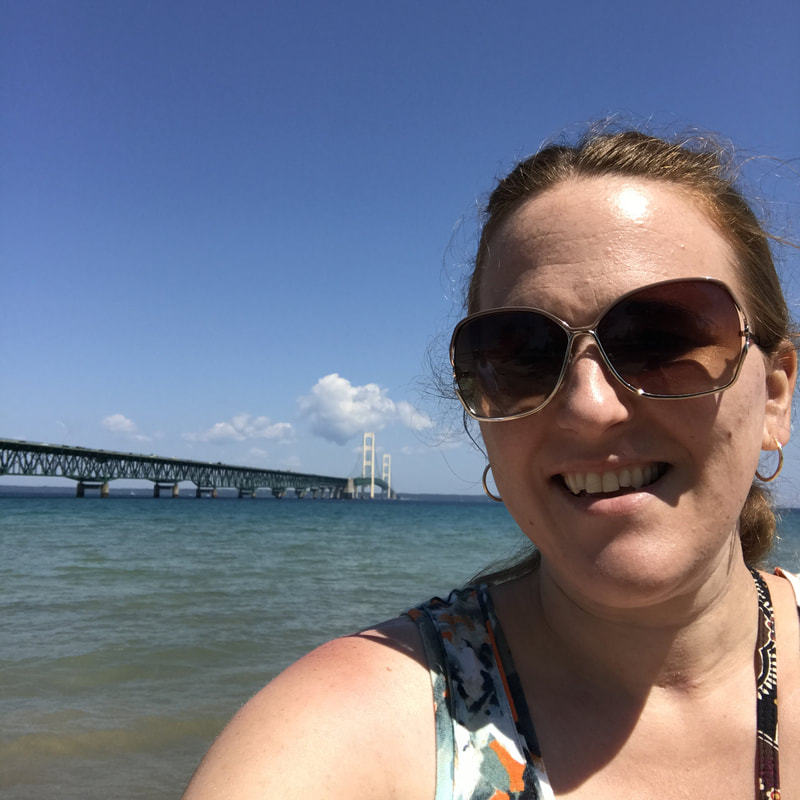The family is listed in the 1880 U.S. Census under the surname 'Kallack.' Franz is listed as Frank (a very common Americanization) and Juditha is listed as 'Euphena.' Three children are listed: Joseph, Loisa, and Caroline. Caroline was born in 1873 and was Franz and Juditha's only child to be born in America. (Loisa, my husband's great-great-grandmother, becomes 'Louisa' as an adult, and marries John M. Braun around 1890.)
|
Franz and Juditha Kahlig are two of my husband's 3x great-grandparents through his maternal grandmother's line. They immigrated to America from Austria (Oesterreich) in August 1871 with their three children, Ludmilla, Josef, and Aloisia. Their ship manifest can be seen below: Although the ship manifest indicates that their destination was Indiana, the Kahlig family ended up settling in Recovery Township, Mercer County, Ohio. The township itself actually shares a border with Indiana, so they were, in fact, very close to Indiana. The family is listed in the 1880 U.S. Census under the surname 'Kallack.' Franz is listed as Frank (a very common Americanization) and Juditha is listed as 'Euphena.' Three children are listed: Joseph, Loisa, and Caroline. Caroline was born in 1873 and was Franz and Juditha's only child to be born in America. (Loisa, my husband's great-great-grandmother, becomes 'Louisa' as an adult, and marries John M. Braun around 1890.) The family's eldest child, Ludmilla, had already married and had a child by the time this census was taken. Her husband was John Spangler and they were living in the same township as her parents. (She and her husband later moved their family across the border to Adams County, Indiana.) Ludmilla adopted the more common first name of 'Amelia' and is referred to as both 'Emma' and 'Ludmilla' in her father's will. According to the 1880 U.S. Agriculture Census, the Kahlig family owned a relatively small farm - a total of 40 acres, with 20 acres being used for production. They had three horses, two milking cows, six swine and, eighty poultry. They grew Indian corn, oats, and wheat. Between 1880 and Franz's death in 1895, twenty more acres of land was added to the farm, as, in his will, Franz explicitly describes the location of sixty acres of land to be given to his wife, Juditha, upon his death. ©2014, copyright Emily Kowalski Schroeder
1 Comment
Ferdinand Wellerding was one of my husband's 4x great-grandfather through his paternal grandmother's line. According to the stone, he was 'aus Steinfeld großhersogtum Oldenburg,' which translates to 'from Steinfeld, Grand Duchy of Oldenburg.' He died on July 11, 1849 at the age of 48 years and 4 months, which indicates that he was born around March 1801. He is buried in St. Augustine's Catholic Cemetery in Minster, Ohio.
I realize how lucky I am to have a stone that actually says where this immigrant ancestor was from. But, other than this, I don't have any other documentation on Ferdinand himself - no records from the Old County, no ship manifest, no census records. Luckily, I do have his daughter's 1914 death certificate in which he is listed as her father, AND her obituary, which tells me more about when and how the family immigrated. Ferdinand, his wife Agnes, and their two children, Maria Katherina and an unnamed brother sailed for America around 1847-1848. They landed in New Orleans. From there, they traveled to Cincinnati before ultimately settling farther north in Auglaize County, Ohio. Unfortunately, according to obituary, Ferdinand and his son died in an 1849 cholera epidemic, while Agnes lived until 1866. Knowing this family's port of entry, I now will be able to begin to comb through New Orleans immigrant ship manifests from the 1847-1848 time period. And when I decide to try to find birth and/or marriage records for Ferdinand and Agnes, I have a pretty good hint as to where geographically to start looking. Photo Source: FindaGrave.com, photographed by Crashlan ©2014, copyright Emily Kowalski Schroeder 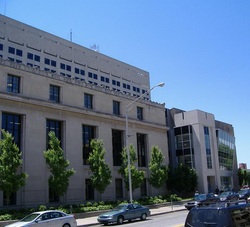 Indiana State Library Indiana State Library Along with trying to keep my kids occupied while they are (still) on winter break from school, I've also been using these first few days of the new year to come up with some genealogy goals for myself for 2014. So, here we go, in no particular order: 1.) Scan more photos. Over the past couple of years, I've done a pretty good job of digitizing photos of my great-grandparents, grandparents, and even the ones from my parents' childhoods. When I was visiting my parents' house for Christmas a couple of weeks ago, I realized how many snapshots they had of me and my own siblings that really, really should be scanned and stored on my cloud drive, just in case anything should happen to them. My siblings and I are far from 'old,' but we did grow up before digital photography, so our entire childhoods are found on these paper photos lying in boxes in my mom's office room. 2.) Get my grandparents' birth certificates and/or baptism records. Three out of four of my grandparents were born in Ohio, so it will probably just take some phone calls or online ordering to get a copy of their birth return or birth certificate. One of my grandmothers was born in Italy. I do know the town in which she was born, but I do not speak or write any Italian, so this is one of my big challenges for this year. I would also love to get my grandparents' baptismal, first communion, and confirmation records, but unfortunately the Catholic Diocese of Cleveland, Ohio Archives office maintains a 'closed to the public' policy. They do have a form by which you can request information by mail, so I may try to do that. 3.) Create family timelines. I would love to be able to take each of my and my husband's direct ancestors and create a visual history of their lives. In particular, I am anxious to try out a program called Timeline JS. I have seen some other family historians make some very cool interactive timelines that do a great job of telling an ancestor's life story. 4.) Tour the Indiana State Library Genealogy Collection. I only live about 25-30 minutes from this library. No, none of my or my husband's direct ancestors ever lived in Indiana, but by searching the catalog, I have found that they do have some holdings about Ohio that may prove useful in my research of my husband's family, in particular. The library offers free tours a couple of times per month, and luckily they are at times during which both of my kids would be at school. Once I am familiar with the library's holdings and layout, perhaps I could persuade my husband to entertain the kids alone some Saturday while I spend the day doing some research there. :-) 5.) Take a two-day trip to the Allen County Public Library in Ft. Wayne. I live about two hours away from this library, the second-largest genealogy library in the nation. I've gone through this library's online catalog several times now, and I KNOW they have holdings that would prove useful to learning about my husband's ancestors. I'd like to be able to get a hotel room and go for two consecutive days, so that I don't have to rush to look through everything I would like. ©2014, copyright Emily Kowalski Schroeder |
Emily Kowalski SchroederArchives
April 2017
Categories
All
|

